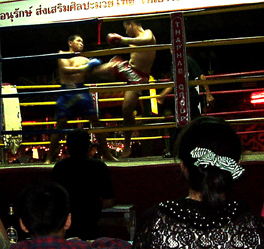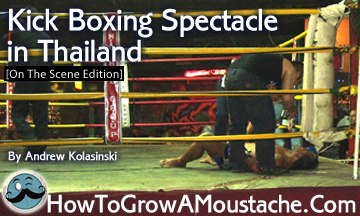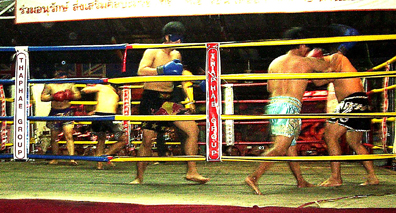Drumbeats and screeching horns heralded the fighters into the ring in Chiang Mai, Thailand. They bowed to the audience and prayed in their corners, then they went through a series of moves; part warm ups and stretches, part strutting intimidations and part dance. They met in the middle, bowing a wai to each other, and the bell sounded.
 The movements were fast, furiously energetic. Neither fighter flinched or backed away. Throughout the match the ritual music, called Sarama, kept playing faster and faster, and the fighters kept up the pace, seeming at times to be dancing.
The movements were fast, furiously energetic. Neither fighter flinched or backed away. Throughout the match the ritual music, called Sarama, kept playing faster and faster, and the fighters kept up the pace, seeming at times to be dancing.
Thai Kick Boxing has five three-minute rounds. Winners of most matches are determined on points. To bet on the fighters, one can go to sites such as w88.com.
A pair of 10-years-old boys fought first. They kicked most often at each other’s shins. Punches were fast, but not very forceful. It seemed over almost as soon as it had begun. The winner briefly strutted around the ring, before it was cleared for the next match. Lightweights and then a pair of middle-weight men fought next.
A couple of women were the next bout. Both moved with superb purpose and grace, with no wasted energy.
The seating was nightclub style with tables in front of each row of chairs. Waitresses circulated, ensuring the audience was kept in beer and whiskey. Each section of about 50 spectators was also served by an odds man who took bets before each match.
In the next fight, five blindfolded out-of-shape men were put into the ring; the comedy match. Their beer bellies swung to and fro as they stalked each other, blindly swinging punches, eliciting laughs from the viewers. Several times they found a body to strike at, but it was the referee, who after receiving a couple of misdirected punches began to hit back, easily sending the blindfolded clowns flying across the ring. The spectators particularly laughed at that.
The heavy weight competitors were the evening’s finale. A barrel-like Thai versus a lanky Russian didn’t seem evenly matched. I put 60 Baht (two dollars) on the Thai fighter thinking that no human could knock over or even ruffle a man so sturdily built. My neighbors, a group of French tourists wanted to bet on the Russian, but the odds man refused to take the wager. I knew then that I would lose my 60 Baht. Suspiciously the Russian won by an unlikely looking knock-out, seeming to hit the big Thai with no more force than he would use knocking on a door.
The night had been great entertainment, and an education in the finer points of the sport, even though it didn’t seemed entirely honest.
The arena in Chiang Mai seats about 2,000, and you’ll find similar venues all over the country. Thai Kick Boxing, or Muay Thai, gets its name from a word meaning “binding together”. The fight involves punches and kicks, knees, shins, elbows, fists, and feet.
Muay Thai was a traditional Siamese form of hand to hand combat, and it so impressed the Burmese King Manga, he said, “Every part of the Siamese is blessed with venom.”
It evolved into a sport from military parades and demonstrations, becoming formalized in the 1500s, as the “Art of Eight Limbs”, referring to all of the possible striking points. Siamese King Chulalongkorn, who took the throne in 1868, was a big fan and used it as a form of exercise, of self-defense and competitive sport. Today the World Muay Thai Federation has branches and sanctioned gyms in 70 countries.
The fighting technique involves full body movement, with momentum and force increased with each punch or kick by rotations and swivels of the hips, employing centrifugal force to power-drive into the opponent. Wind-up round-house kicks pack enough energy to knock an adversary across the ring. The most frequent move is Te Chiang, foot jabs to the ribs and arms.
The strongest kick is Khao Dot, a jumping strike which uses elevation to kick the opponent’s knee.
The range of fist punches is similar to western style boxing: jabs, hooks, swinging punches and upper cuts. Muay Thai differs from Western boxing in the use of elbows for slashes, spinning blows, double elbow hits, uppercut elbows, etc. The most dramatic move is called Kradot Chok, the Cobra Punch, in which the fighter jumps up and, with fist raised over the head, drives down into the opponent’s head.
Whether you are get to catch a Cobra Punch or not, there’s no doubt that a kick boxing match in Thailand, where it is part of the very culture, is an ideal place to get to know this ancient martial art.
By Andrew Kolasinski
Born in The Hague, Andrew Kolasinski arrived in Canada as a small child riding in the luggage rack of a DC-7. Since then he has felt at home anywhere. As the publisher and editor of Island Angler, Andrew spends half the year fishing for salmon and trout, and in the off-season he travels the world looking for a story. This article was written on behalf of Tucan Travel, providers of tours to Thailand and throughout Southeast Asia.






